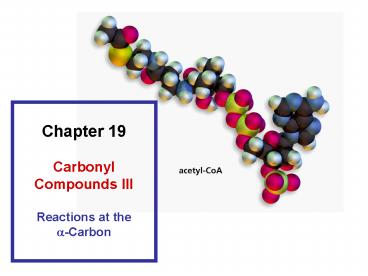Carbonyl Compounds III - PowerPoint PPT Presentation
1 / 60
Title:
Carbonyl Compounds III
Description:
A carbon acid is a compound with a relatively acidic. hydrogen ... The Stork Enamine Reaction. Enamines are used in place of enolates in Michael. reactions ... – PowerPoint PPT presentation
Number of Views:179
Avg rating:3.0/5.0
Title: Carbonyl Compounds III
1
Chapter 19 Carbonyl Compounds III Reactions at
the a-Carbon
2
The a-Hydrogen Is Acidic
the anion is stabilized by resonance
A carbon acid is a compound with a relatively
acidic hydrogen bonded to an sp3-hybridized carbon
3
(No Transcript)
4
Esters Are Less Acidic Than Aldehydes and Ketones
The electrons are not as readily delocalized
5
In these compounds, the electrons left behind
from deprotonation can be delocalized onto a
more electronegative atom
6
The acidity of the a-hydrogens is attributed to
charge stabilization by resonance
7
KetoEnol Tautomerism
8
The enol tautomer can be stabilized by
intramolecular hydrogen bonding
9
(No Transcript)
10
(No Transcript)
11
An Enol Is a Better Nucleophile Than an Alkene
Carbonyl compounds that form enol undergo
substitution reactions at the a-carbon an
a-substitution reaction
12
An Acid-Catalyzed a-Substitution Reaction
13
A Base-Catalyzed a-Substitution Reaction
14
An Enolate Is an Ambident Nucleophile
Reaction at the C or O site depends on the
electrophile and on the reaction condition
Protonation occurs preferentially on the O site
Otherwise, the C site is likely the nucleophile
15
Acid-Catalyzed Halogenation
Under acidic conditions, one a-hydrogen is
substituted for a bromine
16
Base-Promoted Halogenation
Under basic conditions, all the a-hydrogens
are substituted for bromines
17
Conversion of a Methyl Ketone to a Carboxylic Acid
18
Halogenation of the a-Carbon of Carboxylic Acids
19
When the a-carbon is halogenated, it becomes
electrophilic
20
Using LDA to Form an Enolate
21
Alkylation of the a-Carbon of Carbonyl Compounds
22
Two different products can be formed if the
ketone is not symmetrical
23
The less substituted a-carbon can be alkylated if
24
Enamine Reacts with Electrophiles
25
The alkylation step is an SN2 reaction
26
Direct alkylation of a carbonyl compound yields
several products
In contrast, alkylation of an aldehyde or a
ketone using an enamine intermediate yields the
monoalkylated product
27
Aldehydes and ketones can be acylated via an
enamine intermediate
28
The Michael Addition
29
(No Transcript)
30
Mechanism of the Michael Reaction
31
The Stork Enamine Reaction
Enamines are used in place of enolates in Michael
reactions
32
One molecule of a carbonyl compound acts as a
nucleophile and the other carbonyl compound acts
as an electrophile
33
(No Transcript)
34
Ketones are less susceptible than aldehydes to
attack by nucleophiles
35
An aldol addition product loses water to form an
aldol condensation product
36
(No Transcript)
37
The Mixed Aldol Addition
38
One product will be formed if one of the carbonyl
compounds does not have any a-hydrogen
39
Primarily one product can be formed by using LDA
to deprotonate one of the carbonyl compounds
40
Condensation of Two Ester Molecules
41
(No Transcript)
42
The reaction can be driven to completion by
removal of a proton from the b-keto ester
The Claisen condensation requires an ester with
two a-hydrogens and an equivalent amount of base
43
The Mixed Claisen Condensation
44
Because of the difference in the acidities of the
a-hydrogens in the two carbonyl compounds,
primarily one product is obtained
45
(No Transcript)
46
Intramolecular Aldol Additions
47
(No Transcript)
48
The Robinson Annulation
49
Decarboxylation of 3-Oxocarboxylic Acids
50
Acid catalyzes the intramolecular transfer of the
proton
51
A malonic ester synthesis forms a carboxylic acid
with two more carbon atoms than the alkyl halide
52
(No Transcript)
53
Preparation of Carboxylic Acids with Two
Substituents Bonded to the a-Carbon
54
Synthesis of Methyl Ketone by Acetoacetic Ester
Synthesis
55
(No Transcript)
56
Designing a Synthesis to Make New CarbonCarbon
Bonds
57
Preparation of the Ester
58
A Biological Aldol Condensation
59
A Biological Claisen Condensation
60
(No Transcript)































